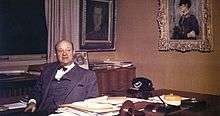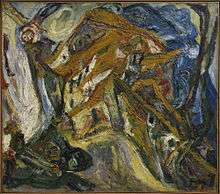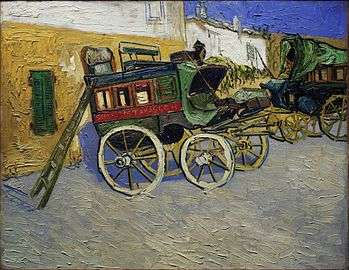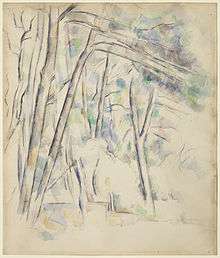Henry Pearlman
| Henry Pearlman | |
|---|---|
 Pearlman in his office at Eastern Cold Storage in New York, NY, with paintings by Modigliani and Manet in the background | |
| Born |
1895 Brooklyn, NY |
| Died | 1974 |
| Nationality | United States |
| Occupation | Founder and CEO of Eastern Cold Storage |
| Known for | Art collector |
| Religion | Jewish |
Henry Pearlman (1895 – 1974) was a Brooklyn-born, self-made businessman who discovered in midlife a passion for impressionist and post-impressionist art. Over three postwar decades, he assembled a “deeply personal”[1] collection centered on thirty-three works by Paul Cézanne and more than forty by Vincent van Gogh, Amedeo Modigliani, Chaïm Soutine, Paul Gauguin, Édouard Manet, Henri de Toulouse-Lautrec and a dozen other European modernists. His eye for quality was “rarely matched in a private collection.”[2]
Early life and business career
Pearlman started his career in the cork insulation business, forming his own company, Eastern Cold Storage Insulation Corporation, at the age of twenty-four and becoming a major player in marine refrigeration. He married Rose Fried in 1925; they raised two daughters in Croton-on-Hudson, eventually living both there and in Manhattan and traveling frequently in pursuit of art.
Art Collector

While Pearlman initially decorated his Croton home with Old Master and American Realist paintings,[3] including those found at local flea markets, his passion for art, and the stories behind each work, found full expression with the purchase at auction in 1945 of an expressionist painting by Chaïm Soutine – View of Céret (formerly Village Square, Céret). As one observer put it, “his first foray into Parisian modernism revealed an acute eye, an instinct for the historical moment and a deeply felt connection to an artist who opened up a new world for him.”[4] Pearlman quickly made connections in the New York art world; he spent time in museums and archives; and he soon traded his decorative collection for carefully selected examples of modern works by impressionist, post-impressionist and expressionist European artists. Pearlman found himself captivated by the details of the lives of and associations among these artists, and his acquisitions often followed such discoveries; he “liked connections and contexts, but as they arose within the framework of his vividly personal taste.”[5] Pearlman was invigorated by the pursuit of quality as well as the challenges of finding, authenticating and negotiating the ownership of increasingly rare masterpieces.
In the years after World War II, Pearlman began traveling to Europe. During an early trip to London he met Austrian expressionist Oskar Kokoschka.[6] This would result in a lifelong friendship for Pearlman with one of the few living artists whose work he collected. On this same trip he also visited the places where Soutine had painted, trying to identify the landscapes he already knew well from their expressionist representation – an activity he would repeat with other artists and works as he built his collection. In his hunt for new works, he looked first to Soutine’s close associates, including Modigliani. Ultimately the collection would include seven paintings by Soutine, and four works by Modigliani, including a rare limestone head and two oil portraits (Léon Indenbaum and Jean Cocteau).

Although successful in business, Pearlman was never able to match the resources of his contemporaries. Instead, “he was both lucky and clever: lucky in that, when he first started, the art he was interested in…could be secured for thousands rather than millions of dollars…and clever in that he continuously honed his eye and then applied his skills… to obtain the objects of his passion.”[7] In 1950 Pearlman learned from a dealer that Van Gogh’s Tarascon Diligence was available from the heirs of the artist Milo Beretta. He quickly offered a combination of paintings and cash to make what is perhaps his most fabled acquisition – the last time a “lost” Van Gogh will reappear for the next sixty-five years.[8] As a reviewer described, this Van Gogh was “a typical Pearlman picture: assertive, pushing a characteristic manner to an extreme that is slightly unusual in the artist’s oeuvre.”[9] Also in 1950, with the advice of noted Cézanne specialist John Rewald, Pearlman made his first purchase of a Cézanne watercolor, Cistern in the Park of Château Noir. Over the following two decades, he would acquire more than thirty works by Cézanne and assemble the most distinguished collection of watercolors by the artist.[10] This new fascination with Cézanne did not distract Pearlman from his expanding interest in the works of other artists who lived and worked in France, many of whom knew, were influenced by and competed with one another. In addition to Modigliani, he added works by Toulouse-Lautrec, Manet, Degas, Renoir and Gauguin as well as several significant oil paintings by Cézanne, including the only known vertical-format[11] of the artist’s favorite subject, Mont Sainte-Victoire. Pearlman continued to build his collection - buying, selling and trading works – for the three remaining decades of his life. His last two purchases were Cézanne watercolors: a late masterpiece (Still Life with Carafe, Bottle, and Fruit) and Rocks at Bibémus, which he had come to know when it appeared alongside works from his collection in a number of exhibitions.[12]
Exhibitions and Legacy

Beginning in the 1950s, Henry and Rose Pearlman began lending individual works to major museums, initially for retrospectives of Soutine[13] and Modigliani.[14] As their collection took shape, loans and exhibitions of the collection became important to them and eventually occupied as much of Henry’s time and attention as acquisitions did. Although he never tired of the hunt, works that met his eye for quality and expressiveness were soon available only to those with the funds, not just a passion.
Pearlman’s generosity extended beyond the loans of works from his collection. He lent financial and other support to artists, including Kokoschka and Jacques Lipchitz, whose studio was destroyed by fire in 1952.[15] Later he allowed his collection to be exhibited as a fundraiser for an organization helping immigrant populations settle in New York.[16] The Henry and Rose Pearlman Foundation was established in 1955 as a not-for-profit organization and is the current owner of the collection. The first exhibition of the collection took place in 1958: twenty-seven selected works, lent anonymously, to the Baltimore Museum of Art.[17] Numerous exhibitions of the collection (in whole and in part) have taken place over the past six decades, including the following: forty-six works were shown at Knoedler & Company in New York in 1959;[18] the Fogg Museum in 1959;[19] the collection was featured in different exhibitions at the Brooklyn Museum of Art in 1960,[20] 1964,[21] 1974[22] and 1986;[23] the Detroit Institute of Art in 1967;[24] the Wadsworth Atheneum in 1970;[25] the National Gallery of Art in 1972,[26] and at the Fine Arts Museums of San Francisco in 1982.[27] A 1960 article in Connoisseur magazine describes Pearlman’s “unflagging fascination of the hunt … [He] trusts a stubborn faith in his own taste and has no interest in assembling an anthology of the standard names of modern art, but only those artists who have a special appeal to his individual taste.”[28] In 1961 Pearlman began making summer loans to museums, starting with the Metropolitan Museum of Art’s “Paintings from Private Collections: Summer Loan Exhibition” series, in part so that the works would be safe and seen while he and Rose were in Croton. (When not on loan, the collection was divided between their Park Avenue apartment and Henry’s office in midtown Manhattan.)

Henry Pearlman spent much of the last year of his life organizing an exhibition of the collection at the Brooklyn Museum,[29] which toured after his death to Princeton,[30] Utica (NY),[31] Williamstown (MA)[32] and the Carnegie Institute in Pittsburgh.[33] The collection returned to the Princeton University Art Museum in 1976, when Rose Pearlman, as head of the foundation, initiated a series of longer-term loans that continue to this day.[34] A world-class university-based museum, Princeton offers the collection security, conservation, curatorial expertise and management of loan requests from museums around the world.
In 2010, the Henry and Rose Pearlman Foundation and the Princeton University Art Museum began plans for a tour of the collection, including its first exhibition outside the United States. With the aim of expanding the audience for these works and artists, the tour (Cézanne and the Modern: Masterpieces from the Henry and Rose Pearlman Collection) opened at the Ashmolean Museum in Oxford, England, in March 2014. Reviewers noted: “A collection of truly stunning art works” (Oxford Times);[35] “Cézanne and the Modern… makes you think about modern art – where it began, and what it is” (The Guardian);[36] “The finest, best preserved collection of Cézanne watercolours in the world” (Financial Times).[37] In July, 2014, it travels to the Musée Granet in Aix-en-Provence, France, where many of the Cézanne works were originally created. The collection returns to North America with three exhibitions: The High Museum in Atlanta, the Vancouver Art Gallery and at Princeton for the fall semester of 2015.
Coinciding with the tour preparations, the Henry and Rose Pearlman Foundation launched a website for the collection. Featuring high-quality images of the entire collection, and offering users the ability to create and share custom galleries from among the works, the site also includes excerpts from Henry Pearlman’s “Reminiscences of a Collector,” with anecdotes about collecting, forgeries, negotiations, dealers and competing collectors. The paper archives of Pearlman’s correspondence and files, held at the Smithsonian Institution’s Archives of American Art, are also linked as well as other external resources, such as the letters of Van Gogh, X-rays of hidden works and connections among the artists represented in the collection.
References
- ↑ Wood, Willis F. (1967). Cézanne and His Contemporaries: The Mr. and Mrs. Henry Pearlman Collection. Detroit. p. np.
- ↑ Anonymous (Feb 1959). "The Pearlman Collection". Arts. 33: 46–47.
- ↑ DeLue, Rachael Z.; et al. (2014). Cézanne and the Modern: Masterpieces of European Art from the Pearlman Collection. Princeton and New Haven: Princeton University Art Museum and Yale University Press. p. 60. ISBN 978-0300174403.
- ↑ Wullschlager, Jackie (14 Mar 2014). "Cézanne and modern masterpieces from the Pearlman Collection". Financial Times. Retrieved 10 April 2014.
- ↑ Wullschlager, Jackie (14 Mar 2014). "Cézanne and modern masterpieces from the Pearlman Collection". Financial Times. Retrieved 10 April 2014.
- ↑ De Lue, Rachael Z.; et al. (2014). Cézanne and the Modern: Masterpieces of European Art from the Pearlman Collection. Princeton University Art Museum and Yale University Press. p. 61. ISBN 978-0300174403.
- ↑ B. B. (3 Apr 2014). "A rare feast". The Economist. Retrieved 10 April 2014.
- ↑ Genauer, Emily (3 Sep 1950). "Art and Artists: A Van Gogh, New to America, Acquired by Private Collector,". The New York Herald Tribune.
- ↑ Wullschlager, Jackie (14 Mar 2014). "Cézanne and modern masterpieces from the Pearlman Collection". Financial Times. Retrieved 10 April 2014.
- ↑ Armstrong, Carol and, Laura Giles, eds. (2002). Cézanne in Focus: Watercolors from the Henry and Rose Pearlman Collection. Princeton: Princeton University Art Museum.
- ↑ Rewald, John (1996). The Paintings of Paul Cézanne: A Catalogue Raisonné. New York: Abrams. pp. 535–537.
- ↑ De Lue, Rachael Z.; et al. (2014). Cézanne and the Modern: Masterpieces of European Art from the Pearlman Collection. Princeton University Art Museum and Yale University Press. p. 68. ISBN 978-0300174403.
- ↑ Wheeler, Monroe (1950). Soutine. Museum of Modern Art, New York in collaboration with the Cleveland Museum of Art.
- ↑ Soby, James Thrall (1951). Modigliani: Paintings, Drawings, Sculpture. New York: Museum of Modern Art.
- ↑ "Jacques Lipchitz studio fund invoice, 1952? (Digital ID: 14010), Jacques Lipchitz papers and Bruce Bassett papers concerning Jacques Lipchitz, Archives of American Art, Smithsonian Institution.". Retrieved 10 April 2014.
- ↑ M. Knoedler & Co. (1959). A Loan Exhibition of Paintings, Watercolors and Sculpture from the Collection of Mr. and Mrs. Henry Pearlman for the Benefit of Greenwich House. New York.
- ↑ Baltimore Museum of Art (July–Sept 1958). Anonymous Collection Exhibition. Check date values in:
|date=(help) - ↑ M. Knoedler & Co. (1959). A Loan Exhibition of Paintings, Watercolors and Sculpture from the Collection of Mr. and Mrs. Henry Pearlman for the Benefit of Greenwich House. New York.
- ↑ Fogg Museum (Exhibition, 1 July–1 Sept. 1959). Drawings, Watercolors and Oils by Paul Cézanne Lent by an Anonymous Collector. Cambridge, Mass. Check date values in:
|date=(help) - ↑ Brooklyn Museum of Art (Exhibition, 29 June–5 Sept. 1960). An Exhibition of 19th & 20th Century Painting and Sculpture from the Collection of Mr. and Mrs. Henry Pearlman. Check date values in:
|date=(help) - ↑ Brooklyn Museum of Art (Exhibition, 22 May–15 Oct. 1964). The Henry Pearlman Collection. Check date values in:
|date=(help) - ↑ An Exhibition of Paintings, Watercolors, Sculpture and Drawings from the Collection of Mr. and Mrs. Henry Pearlman and Henry and Rose Pearlman Foundation. New York: Brooklyn Museum of Art. 1974.
- ↑ Brooklyn Museum of Art (Exhibition, 2 May–14 July 1986). Art of Cézanne from the Henry and Rose Pearlman Foundation. Check date values in:
|date=(help) - ↑ Cézanne and His Contemporaries: The Mr. and Mrs. Henry Pearlman Collection. Detroit: Detroit Institute of Arts. 1967.
- ↑ Impressionism, Post-impressionism, Expressionism: The Mr. & Mrs. Henry Pearlman Collection of Works by Cézanne, Van Gogh, Degas, Toulouse Lautrec, Manet, Modigliani, Soutine, and Others. Hartford, Conn.: Wadsworth Atheneum. 1970.
- ↑ National Gallery of Art, Washington D.C. (Exhibition, 14 Apr.–30 Sept. 1972). Cézanne Watercolors from the Collection of Mr. and Mrs. Henry Pearlman. Check date values in:
|date=(help) - ↑ Fine Arts Museums of San Francisco (Exhibition, 26 June–29 Aug. 1982). Paul Cézanne: Works from the Pearlman Collection. Check date values in:
|date=(help) - ↑ Chanin, A. L. (June 1960). "The Henry Pearlman Collection". Connoisseur. 145 (586): 230–236.
- ↑ An Exhibition of Paintings, Watercolors, Sculpture and Drawings from the Collection of Mr. and Mrs. Henry Pearlman and Henry and Rose Pearlman Foundation. New York: Brooklyn Museum of Art. 1974.
- ↑ Art Museum, Princeton University (Exhibition, 8 Dec. 1974–14 Mar. 1975). An Exhibition of Paintings, Watercolors, Sculpture and Drawings from the Collection of Mr. and Mrs. Henry Pearlman and Henry and Rose Pearlman Foundation. Check date values in:
|date=(help) - ↑ Munson-Williams-Proctor Institute (Exhibition, 13 Apr.–31Aug. 1974). An Exhibition of Paintings, Watercolors, Sculpture and Drawings from the Collection of Mr. and Mrs. Henry Pearlman and Henry and Rose Pearlman Foundation. Utica, New York. Check date values in:
|date=(help) - ↑ Francine and Sterling Clark Institute (Exhibition, 26 Sept. 1975–22 Feb. 1976). An Exhibition of Paintings, Watercolors, Sculpture and Drawings from the Collection of Mr. and Mrs. Henry Pearlman and Henry and Rose Pearlman Foundation. Williamstown, Mass. Check date values in:
|date=(help) - ↑ Carnegie Institute (Exhibition, 6 Apr.–30 May 1976). An Exhibition of Paintings, Watercolors, Sculpture and Drawings from the Collection of Mr. and Mrs. Henry Pearlman and Henry and Rose Pearlman Foundation. Pittsburgh. Check date values in:
|date=(help) - ↑ Shirey, David L. (27 June 1976). "Princeton Gets Pearlman Art for 2 Years". New York Times: 26.
- ↑ Thompson, Theresa (20 Mar 2014). "A collection of truly stunning art works". The Oxford Times. Retrieved 10 April 2014.
- ↑ Jones, Jonathan (10 Mar 2014). "Cézanne and the Modern review – 'puts Ashmolean in the big league". The Guardian. Retrieved 10 April 2014.
- ↑ Wullschlager, Jackie (14 Mar 2014). "Cézanne and modern masterpieces from the Pearlman Collection". Financial Times. Retrieved 10 April 2014.
Bibliography
Primary Sources
Archives of American Art, Smithsonian Institution, Washington, D.C., Henry and Rose Pearlman papers, 1893-1995 (bulk 1950-1980).
The Brooklyn Museum Libraries and Archives, Records, Exhibition negatives: installations. 38 Post-Impressionist Works from the Collection of Mr. and Mrs. Henry Pearlman.1964.
The Brooklyn Museum Libraries and Archives, Records, Records, Exhibition views: installations. Paintings, Watercolors, Sculpture and Drawings from the Collection of Mr. and Mrs. Henry Pearlman. 1974.
Henry Pearlman. Reminiscences of a Collector. Princeton, 1995. ISBN 9780943012209
Secondary Sources
A Loan Exhibition of Paintings, Watercolors and Sculpture from the Collection of Mr. and Mrs. Henry Pearlman for the Benefit of Greenwich House. Exh. cat. New York, 1959. Exhibition, M. Knoedler & Co., New York, 27 Jan.–12 Feb. 1959.
An Exhibition of 19th & 20th Century Painting and Sculpture from the Collection of Mr. and Mrs. Henry Pearlman. Exhibition, Brooklyn Museum of Art, New York, 29 June–5 Sept. 1960. Published checklist.
An Exhibition of Paintings, Watercolors, Sculpture and Drawings from the Collection of Mr. and Mrs. Henry Pearlman and Henry and Rose Pearlman Foundation. Exh. cat. New York, 1974. Exhibition, Brooklyn Museum of Art, New York, 22 May–29 Sept. 1974; Art Museum, Princeton University, 8 Dec. 1974–14 Mar. 1975; Munson-Williams-Proctor Institute, Utica, N.Y., 13 Apr.–31Aug. 1974; Francine and Sterling Clark Institute, Williamstown, Mass., 26 Sept. 1975–22 Feb. 1976; Carnegie Institute, Pittsburgh, 6 Apr.–30 May 1976.
Anonymous. "Pearlman Collection: Taste with a Reverse Twist." Art News (Feb. 1959), pp. 26–27, 63.
Anonymous. "The Pearlman Collection." Arts 33 (Feb. 1959), pp. 46–47.
John Ashbery, “Cultured Pearls,” New York Magazine (5 Aug. 1974), p. 62.
A. L. Chanin. "The Henry Pearlman Collection." Connoisseur 145, no. 586 (June 1960), pp. 230–36.
Cézanne and His Contemporaries: The Mr. and Mrs. Henry Pearlman Collection. Exh. cat. Detroit, 1967. Exhibition, Detroit Institute of Arts, 14 June–1 Oct. 1967.
Rachael Z. DeLue et al., Cézanne and the Modern: Masterpieces of European Art from the Pearlman Collection (New Haven and Princeton, 2014). ISBN 9780300174403
Laura M. Giles and Carol Armstrong, eds. Cézanne in Focus: Watercolors from the Henry and Rose Pearlman Collection. Exh. cat. Princeton, 2002. Exhibition, Princeton University Art Museum, 19 Oct. 2002–12 Jan. 2003.
Impressionism, Post-impressionism, Expressionism: The Mr. & Mrs. Henry Pearlman Collection of Works by Cézanne, Van Gogh, Degas, Toulouse Lautrec, Manet, Modigliani, Soutine, and Others. Exh. cat. Hartford, Conn., 1970. Exhibition, Wadsworth Atheneum, Hartford, Conn., 10 June–4 Oct. 1970.
Jonathan Jones, “Cézanne and the Modern review – 'puts Ashmolean in the big league,'” The Guardian (10 Mar. 2014).
John Russell, “In Pearlman Art Display, the Coups of a Collector,” New York Times (23 May 1974).
Sixteen Watercolors by Cézanne from the Collection of Mr. and Mrs. Henry Pearlman. Exh. cat. New York, 1973. Exhibition, Paul Rosenberg & Co., New York, 16 Oct.–16 Nov. 1973.
Summer Loan 1971: Paintings from New York Collections: Collection of Mr. and Mrs. Henry Pearlman and The Henry and Rose Pearlman Foundation. Exhibition, The Metropolitan Museum of Art, New York, 13 July–7 Sept. 1971. Published checklist.
Theresa Thompson, “A collection of truly stunning art works,” The Oxford Times (20 Mar. 2014).
Jackie Wullschlager, “Cézanne and modern masterpieces from the Pearlman Collection,” Financial Times (14 Mar. 2014).
External links
| Wikimedia Commons has media related to Henry and Rose Pearlman Collection. |